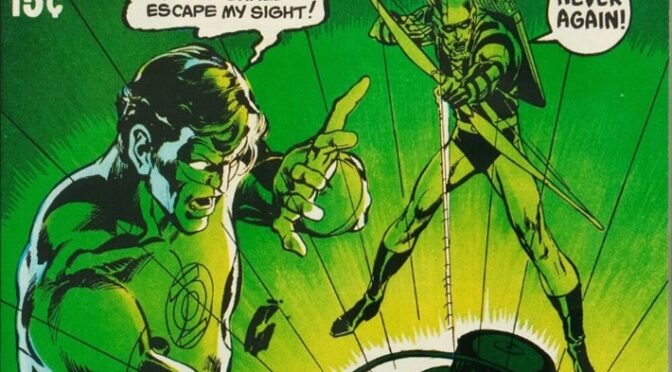
By Mx Kris Vyas-Myall
Last time I talked about popular music, I noted there was a battle between the past and the future. Looking at the sales figures today, it seems like the desire for nostalgia has won out. Around half the top 40 singles and over a third of the top 40 albums are in the country-folk-blues-rock style that is currently in vogue. The sound pioneered by The Band, CCR, Canned Heat and Buffalo Springfield (among others).
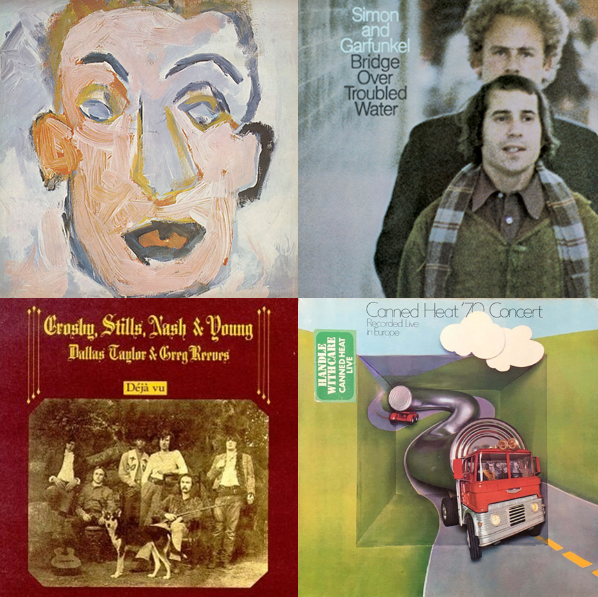
Some of the albums people are currently buying in droves
Furthermore, in a reverse of the British Invasion, it has been overwhelmingly American artists that have been selling, often singing about the old America. Whether this be The Beach Boys talking about the “cottonfields back home” (apparently, they no longer love California Girls), Elvis opining being “in the cold Kentucky rain” or CSNY telling us “country girl I think you’re pretty”, it seems Americana is big. Even British groups have been getting in on the act, with Christie saying they are “on [their] way to Yellow River” and Mungo Jerry singing the San Francisco Bay Blues, even though I doubt if any of them have spent much time on US soil.

And singles that remain stubbornly in the charts over the summer
This has also extended to the more liberal themed songs in the charts, which seem to be about how America has gone wrong, whether that be Marvin Gaye’s version of Abraham, Martin and John or Joni Mitchell lamenting that “they paved paradise, put up a parking lot”.
The question of “what has happened to America?” seems to be one everyone is asking, and it has even entered into the world of comic books:
Green Lantern, Co-Starring Green Arrow
DC comics has not really been holding its own against Marvel recently. They launched a few interesting new characters but they have mostly disappeared from the shelves. This shake-up of three existing crime-fighters is unlike anything I have ever seen in the world of superheroes.
The Green, The Black & The Other Green
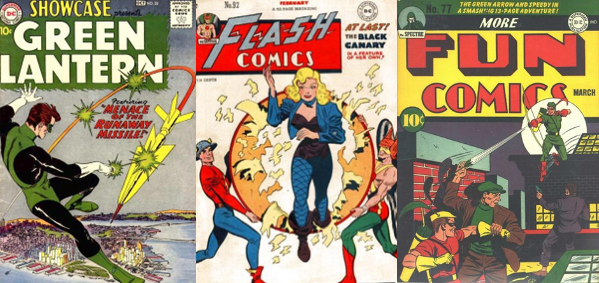
Our respective heroes' earliest covers
First, I think we need a bit of history on our protagonists (much of this I thank my learned American colleagues for). In the superhero revival of a decade ago, Green Lantern was the second to be reimagined, following on the footsteps of The Flash. The new GL, Hal Jordan, is more aligned with Smith’s Lensman series, kind of a cross between a galactic peacekeeper and a beat cop, reporting to the immortal Guardians of the Universe. His power to do this comes from a ring that can do, more or less, anything the wearer imagines.
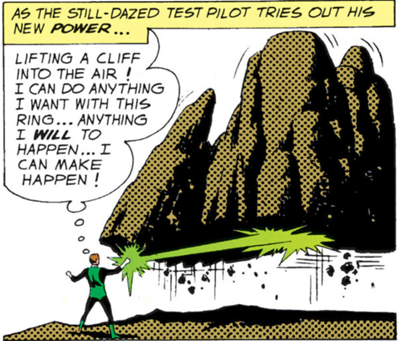
Hal Jordan displays his powers…and demonstrates the title’s flaw
Initially the series was very successful, but over the last decade sales have dropped by around 40%. Partially this is down to a dip all their titles are taking with price increases and Marvel competition, but this is steeper than many others. I think the other factor is that the stories have become a bit rote. His ring can do nearly anything, including make him practically indestructible. There will be some pretense at adding tension, such a Jordan being mind-controlled or forgot to charge his ring, but it will then turn out the ring can do something else or Jordan was just pretending, and will fly home to smirk at the camera.
In addition, Hal Jordan has, to me, been given even less personality than most of his hero stablemates. He just seems to be a blank slate for adventures to be drawn on top of. If he is to survive as a hero, there needs to be a change.
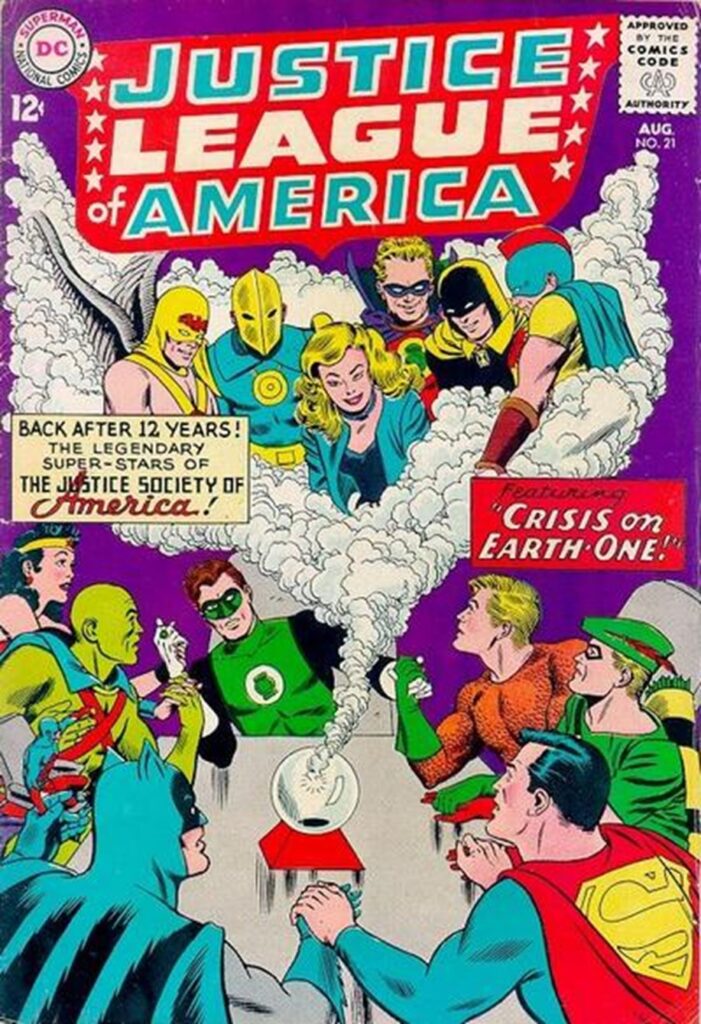
Black Canary (top row, centre) returning in a puff of smoke
A more recent revival is Black Canary. Dinah Drake Lance was originally created as a side-character in the Johnny Thunders comics but was soon popular enough to get her own strip. Whilst appearing to the rest of the world as an unassuming florist, she was actually a judo expert and would often go undercover as a criminal to track down evildoers. She would also, surreptitiously, get information from her future husband and private detective, Larry Lance. She continued as a back-up story for the rest of the first run of Flash Comics until its demise in 1949.
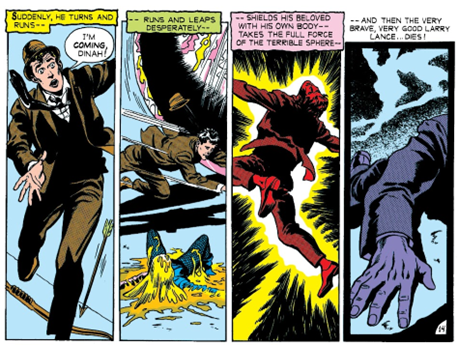
Larry’s sacrifice
Once cross-universe antics began taking place with some regularity, it was time for the Justice League of America to meet their forerunners in the Justice Society of America; one of these being Black Canary. The most recent crossover is the one that is important for our purposes. The Justice Society and Justice League are forced to battle each other by Aquarius. When Dinah’s life is threatened Larry breaks out from the trance he is in and sacrifices himself to save Black Canary.
Heartbroken at what has happened, Dinah elects to try to make a new life in this unfamiliar universe. In a real-world level there is an obvious reason for her crossing over to the Justice League. With Wonder Woman losing her powers and quitting, it had become an all-male group and DC hadn’t exactly been stellar at trying to bring back more women heroes again. The main other options are Hawkgirl (whose powers are a duplicate for existing member Hawkman), Supergirl (whose powers are a duplicate for existing member Superman) and Zatanna (who has only made a few appearances so far).
She also had a slight reworking of her power-set with less focus on her undercover work to date but with the addition of a motorcycle (specially built by Superman) and an ability to unleash sonic waves, in the style of the X-Men’s Banshee.
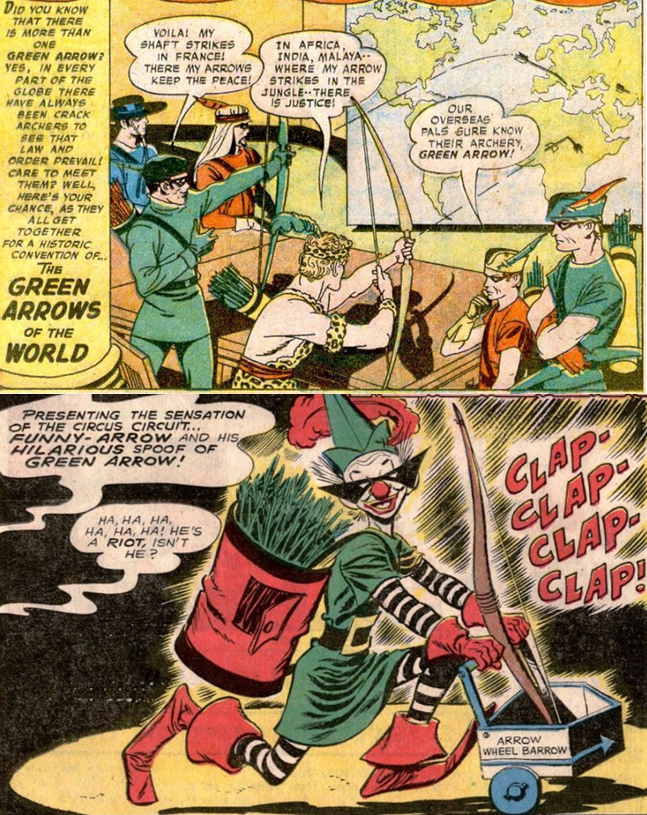
A couple of the less impressive openings in the latter days of Green Arrow’s ongoing strips
Green Arrow, on the other hand, never had a revival because he didn’t disappear. Between 1941 and 1964, Oliver Queen and his adopted son, Roy Harper, were regularly foiling criminals with their bows and arrows. However, the concept got cuter and duller as it went on. Even a period with Jack Kirby’s artwork did little to refresh him and Green Arrow became reduced to a lesser character on the Justice League’s roster. This all changed a few months ago thanks to a combination effort between DCs two new young stars, Neal Adams and Denny O’Neil.
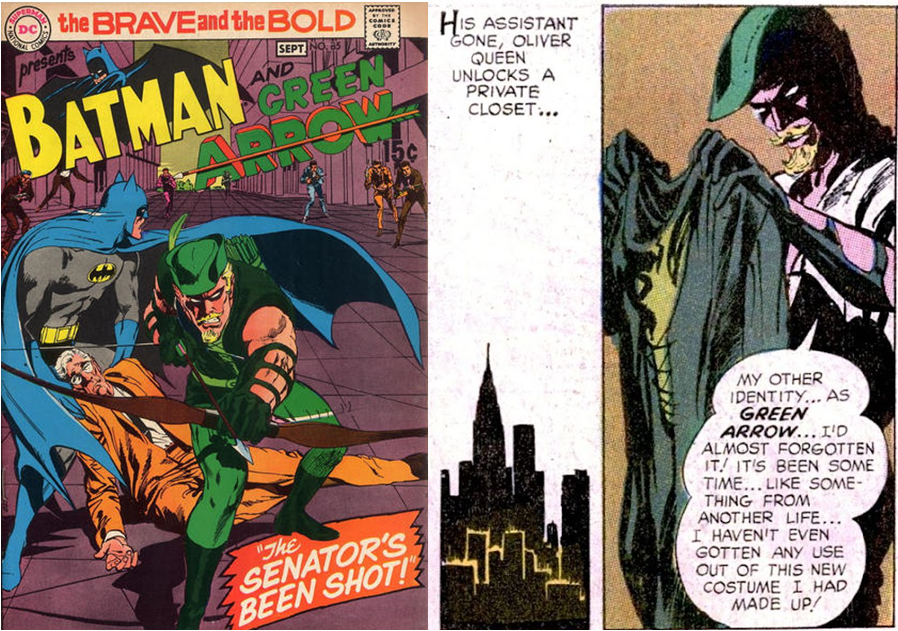
Green Arrow gets a new costume
Firstly, artist Adams gave him a whole new look in the Batman team-up title, the Brave and the Bold. Gone is the clean-cut skinny look, he now has an Errol Flynn style beard, archer’s bracers and muscles that make you believe he could shoot an arrow through a tank. The story is also deeper and darker than Bob Haney’s usual brand of storytelling, with both heroes working to bring down organized crime, whilst pondering whether being a billionaire or a superhero is more important.
After taking over the Justice League of America, writer Dennis O’Neil pulled at these threads further. Over the course of a few issues Green Arrow lost his fortune, met an id version of himself that criticized him as a hypocrite and saw his city suffer environmental disaster. In addition, he is given the start of a potential romance with Black Canary and made the conscience of the Justice League, often getting the last word on O’Neil’s more socially conscious brand of storytelling.
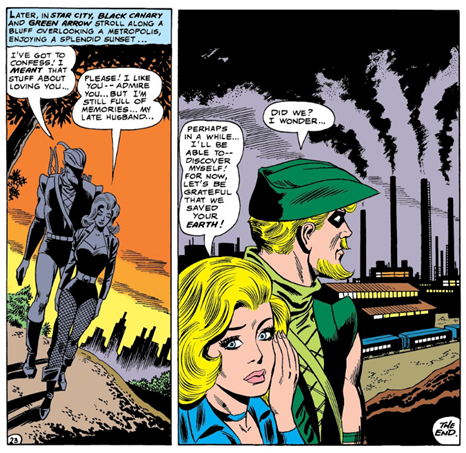
The subtle left-wing messages being snuck into Justice League of America
So, we now have a title desperately in need of resuscitation, one hero lost in a new dimension and another having a crisis of identity. Where could this all be going?
Evil Escaped My Sight
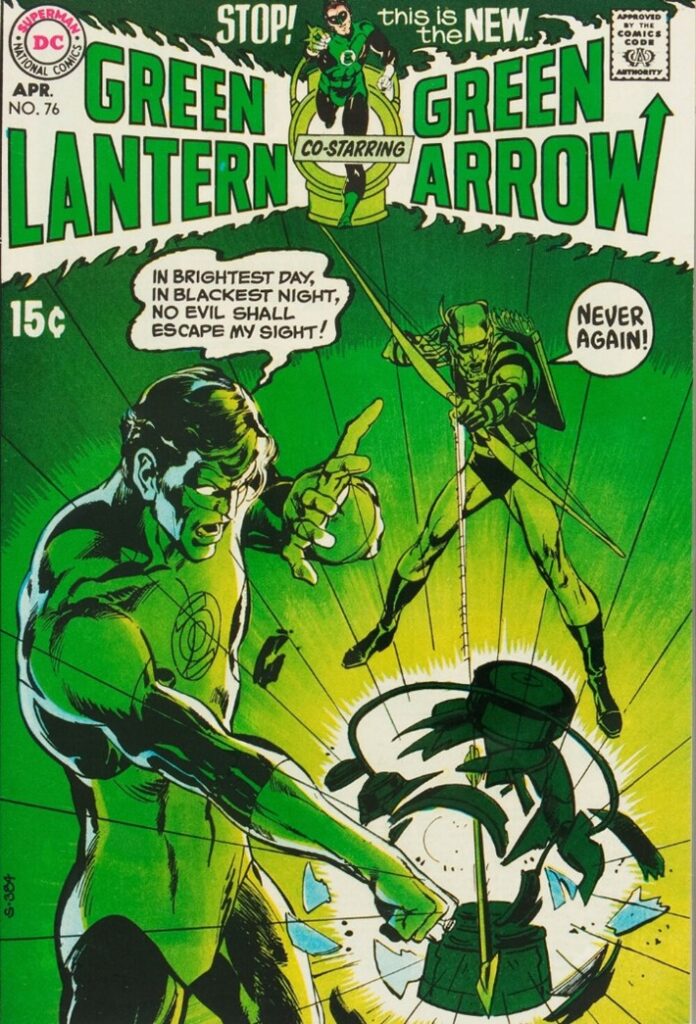
Just look at this cover! How could you not want to pick that up?
Well, it would be to Green Lantern #76 or, as it says on the cover, Stop! This is the NEW Green Lantern co-starring Green Arrow. It starts in the usual manner, Green Lantern patrols through the skies, sees someone arguing and tries to protect the recipient of abuse using his power ring. But then the residents of the nearby buildings start hurling rubbish and abuse at GL. When he threatens to use his powers to punish them, Green Arrow turns up to tell him that if he raises a finger GA will fight him.
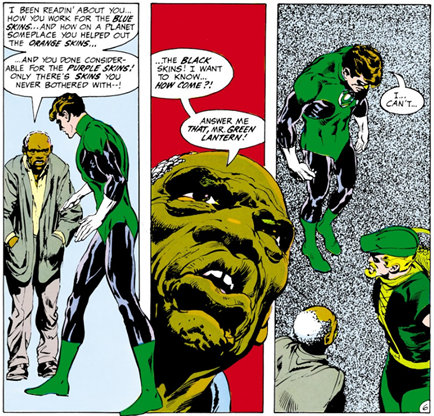
An old guy speaks truth to power
At this point in a usual comic book, they would probably start fighting and then have it revealed GA is under some kind of mind control. Instead, he takes Green Lantern on a tour of the building, it turns out the man being abused was a slumlord who is planning to throw his tenants out on to the street and convert the space to a parking lot. Seeing the reality of the situation begins to make Lantern question if his role is merely to uphold the law?
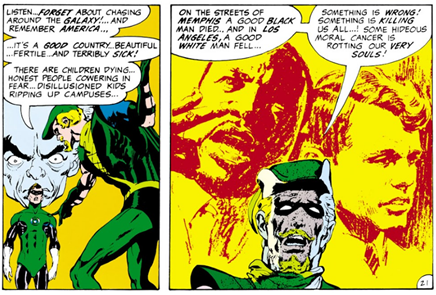
Oliver Queen expressing the outrage we have all been feeling over the last few years
This in itself would have been enough to get the entire creative team up before HUAC a decade ago, but they go further. Eventually the pair manage to discover shady dealings of the slumlord and get him indicted by the DA. However, Green Lantern’s bosses, The Guardians of the Universe, are not pleased at this turn of events. They wanted him to be diverting a meteorite storm, not getting involved in a local human matter. Green Arrow is not having any of this and tells the Guardians directly that America has real problems that cannot be solved by slugging supervillains in space.

And we’re off!
Accepting that there may be some wisdom to his words, The Guardians send down one of their number to experience life on Earth. He joins Hal and Oliver in an old pickup truck, to find the real America.
Hello Birdie
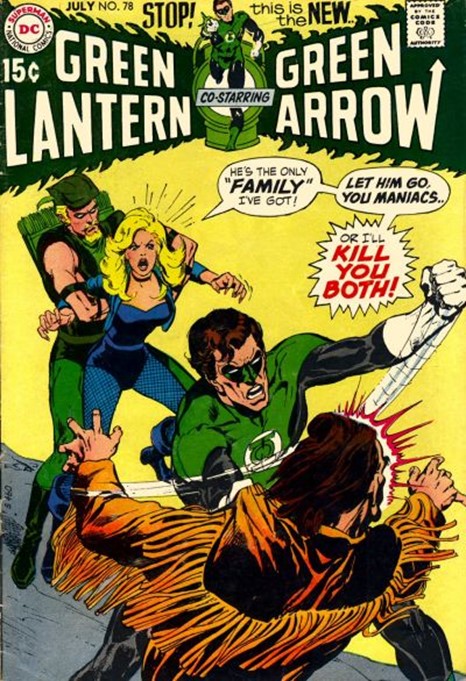
After an issue dealing with union busting in a mining town, the focus turns to Black Canary. She initially had not joined the trip across America, instead staying with the Justice League, but eventually decided to follow behind on her motorcycle. However, when battling a gang called The Demons (read Hell’s Angels) one of them surprises her and runs her over. From the side of the road, she is rescued by a man called Joshua. He is a hippy cult leader who lives in a commune with his “family” which she finds herself involved with. She is drawn to his magnetic power, even when he wants them to kill to incite a race war. Yes, she essentially comes under the spell of Charles Manson!
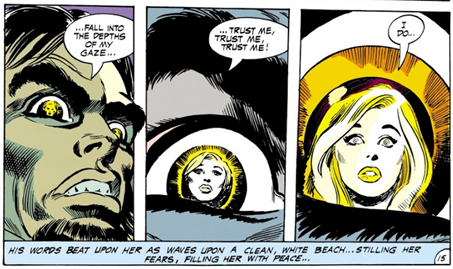
It is when Joshua tries to get her to kill Green Arrow she finally snaps out of it and the heroes are able to stop him. But it leads to them asking interesting questions: did Joshua have some special mind control power? Is it that Dinah is more vulnerable due to her recent losses? Or is it something in all of us that makes us vulnerable to charismatic leaders and their bigotry?
No Simple Answers
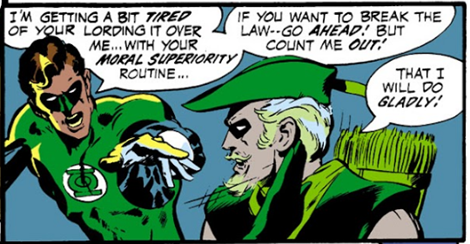
It would be easy for this to become a series of morality plays but, in these first four issues, none of the deeper problems have been truly solved. The slumlord is in prison and the building saved but the residents still have substandard housing. The miners are no longer controlled by a cruel boss but are still doing back-breaking work in poverty. Joshua’s Family is broken up, but other cult leaders are just as likely to rise up. And even if they are being looked at by the courts, Native American land rights are still regularly ignored.
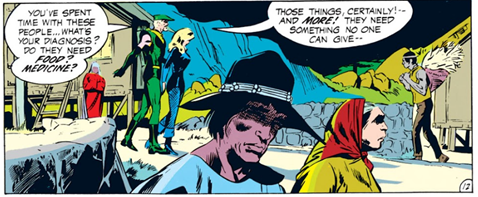
The story is instead meditations on the problems of contemporary America with the different members of the trip believing there are different ways to resolve them. Green Lantern believes that solutions can still be found within the existing system. Green Arrow believes that law as it stands is broken. The Guardian believes that the nature of humanity needs to be changed, to channel its focus away from its aggression towards star flight. Black Canary’s response is probably the most interesting to me. Rather than political, her thoughts are more empathetic, that people are losing hope and need something to believe in again.
A Masterpiece
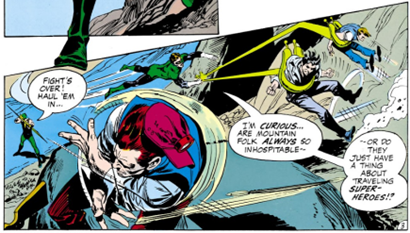
I have spent much of my word count discussing the stories and their themes, but I do think I need to address Neal Adams’ brilliant artwork. He seems to understand movement better than anyone else I know. In complicated scenes, you are able to understand exactly what is going on, how people are feeling, and how to read it, as if you are watching a master film director at work.
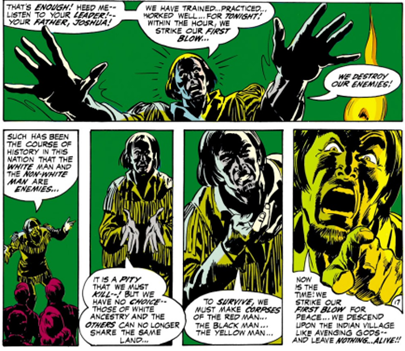
He also knows how to use shadow to great effect. The average comic book artist will light things as if you are watching a studio sitcom, so you can see all the details needed to tell the story. Adams makes extensive use of light and dark to give both a sense of realism and drama.
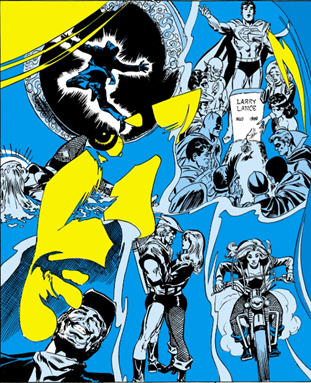
Conversely, it should be noted Adams is not afraid to make use of more complicated effects if required. Whether that be The Guardian communing, Green Lantern trapped in a burning building or flashbacks in the mind, he is willing to get creative, but only if it is necessary to tell the tale. That combination of artistry and restraint is extremely rare and something that I want to applaud.
Obviously, this mag gets Five Stars from me, but I would go further. I think it has the potential to be revolutionary. I do not mean I want Peter Parker and Tony Stark to reenact Easy Rider; just that comic books can be so much more than they currently are. Just as the New Wave in prose SF showed that not every science fiction story needs to be a formulaic problem piece, neither do superheroes need to be endlessly punching each other over lame quips before getting down to fighting someone dressed as a zoo animal. If the 70s can be a decade where comics grow up, it will be an exciting one indeed.

